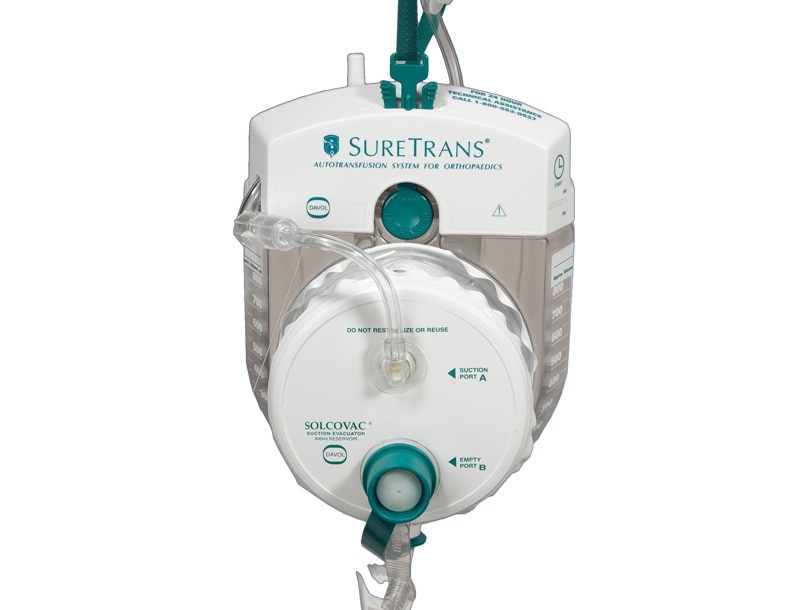Indications
Simultaneous collection and reinfusion of autologous shed blood following orthopedic surgery.
Contraindications
- Systemic infections.
- Suspected infection of wound or drain site(s).
- Septic contamination of autologous blood.
- Malignant neoplasms in the area of blood accumulation.
- Collected blood containing topical hemostatic agents, topical antiseptics or antibiotics contraindicated for systemic use.
Warnings
- DUE TO THE POTENTIAL FOR AIR EMBOLISM, DO NOT PRESSURE REINFUSE WHILE USING THE SURETRANS™ AUTOTRANSFUSION TRANSFER BAG.
- This device has been designed for single use only. Reuse, reprocessing, resterilization or repackaging may compromise the structural integrity and/or essential material and design characteristics that are critical to the overall performance of the device and may lead to device failure which may result in injury to the patient. Reuse, reprocessing, resterilization or repackaging may also create a risk of contamination of the device and/or cause patient infection or cross infection, including, but not limited to, the transmission of infectious diseases from one patient to another. Contamination of the device may lead to injury, illness or death of the patient or end user.
- To reduce the possibility of infection when reinfusing autologous shed blood, “The time from collection to expiration should be less than 6 hours for recovered blood that is not processed.” (AABB. (2010) Guidelines for Blood Recovery and Reinfusion in Surgery and Trauma; pp. 10-11). For proper identification, record the patient’s name, ID number and time collection was initiated on the collection container label.
- Autotransfusion of wound drainage blood has been associated with complications due to blood trauma. Coagulopathy and embolism from particulate, fat and air have been reported. Proper procedural techniques should be followed to avoid such complications.
- Salvaged blood deficient in coagulation factors may, on reinfusion, dilute the patient’s clotting factors in vivo and promote postoperative bleeding. Therefore, monitoring of the patient’s coagulation status is necessary to avoid coagulopathy.
- Anticoagulant (ACD-A) may be used at the discretion of the physician. Determination of the amount of anticoagulant to be used should be adjusted according to the patient’s condition and type of procedure. Careful attention should be paid to the amount of anticoagulant used and the amount of shed blood collected so as not to exceed 15 mL of ACD-A anticoagulant for every expected collection of 100 mL of blood. Per AABB Guidelines, the administration rate for citrate-bearing anticoagulants is 15 mL per 100 mL of collected blood. (AABB. (2010) Guidelines for Blood Recovery and Reinfusion in Surgery and Trauma; pp. 3-4). The ratio should be followed to prevent reactions such as citrate toxicity or bleeding tendency. In the event of suspected citrate toxicity, calcium administration should be considered.
- A 20-40 micron microaggregate blood filter is required for use during blood reinfusion.
- Prior to reinfusion, fully prime the blood administration set to remove air. Also, monitor the infusion line for the presence of air during reinfusion.
- The one-way valve must be replaced by the tethered plug on port (B) of the Solovac™ suction reservoir when using it for drainage collection to prevent leakage.
- When collection unit contains more than 500 mL of fluid, the SureTrans™ unit must be kept upright.
- To avoid the possibility of drain damage or breakage:
- Additional perforations should not be made in the drain.
- Avoid suturing through drain.
- Drain should lie flat and in line with t he skin exit areas.
- Particular care should be taken to avoid any obstacles to the drain exit path.
- Drain should be checked during closure for free motion to avoid possibility of breakage.
- Drain removal should be done gently by hand. It should not be handled with pointed, toothed or sharp instruments which could cause cuts or nicks and lead to subsequent structural failure of the drain.
- Surgical removal may be necessary if drain is difficult to remove or breaks.
Cautions
- Read all instructions prior to use.
- To help prevent serious adverse events such as allergic reactions to autologous blood transfusions, all transfusion and medical society guidelines, as well as, hospital and institution specific rules, regulations and requirements must be strictly followed.
- Aseptic technique should be used when exposing and making all connections.
- Prior to use, ensure that the round white stickers on the 3 Quick-Disconnect Luer-Locks are not damaged or broken. All connections must be properly secured to provide an airtight system.
- The closed wound drain(s) must be firmly inserted into the Y-connector. The eyes of the drain(s) should not be exposed.
- To ensure proper blood flow during collection and reinfusion, routinely check the tubing for patency and make sure that the clamps are open.
WARNING: This product can expose you to di(2-ethylhexyl) phthalate (DEHP), which is known to the State of California to cause cancer and birth defects or other reproductive harm. For more information, go to: https://www.P65Warnings.ca.gov.

